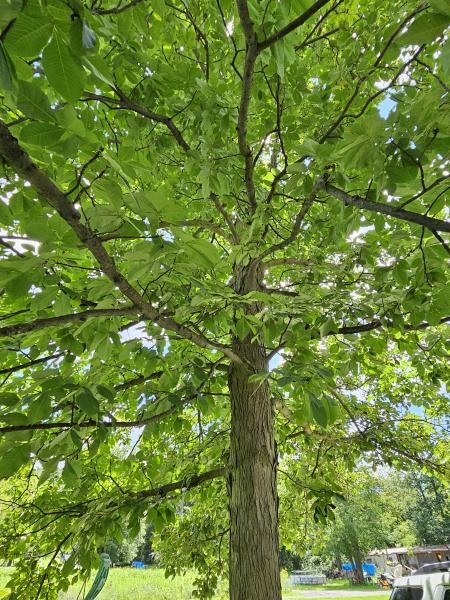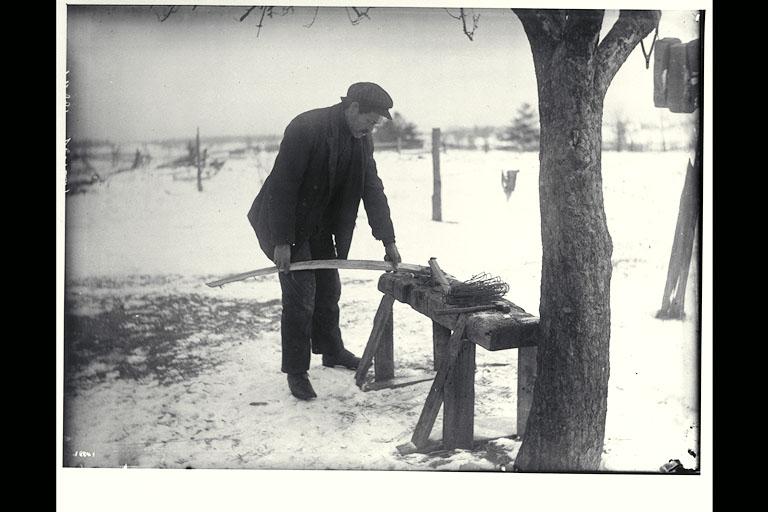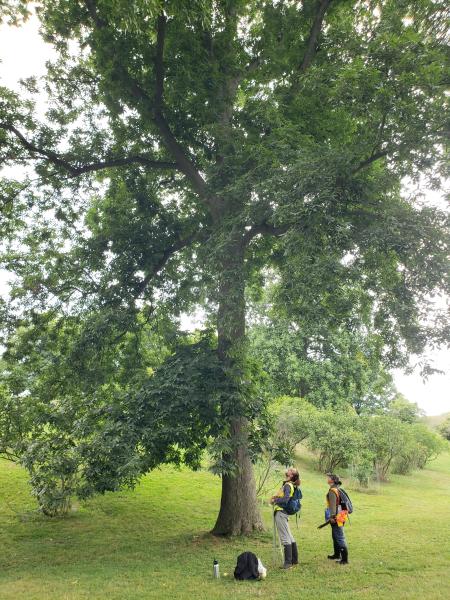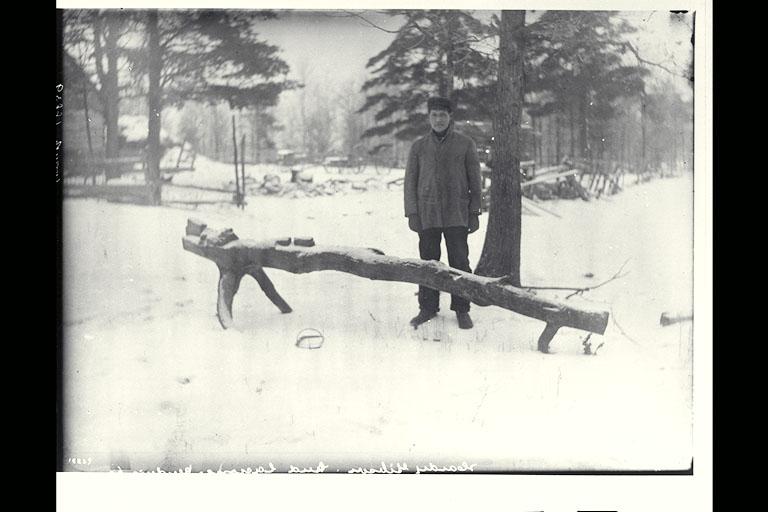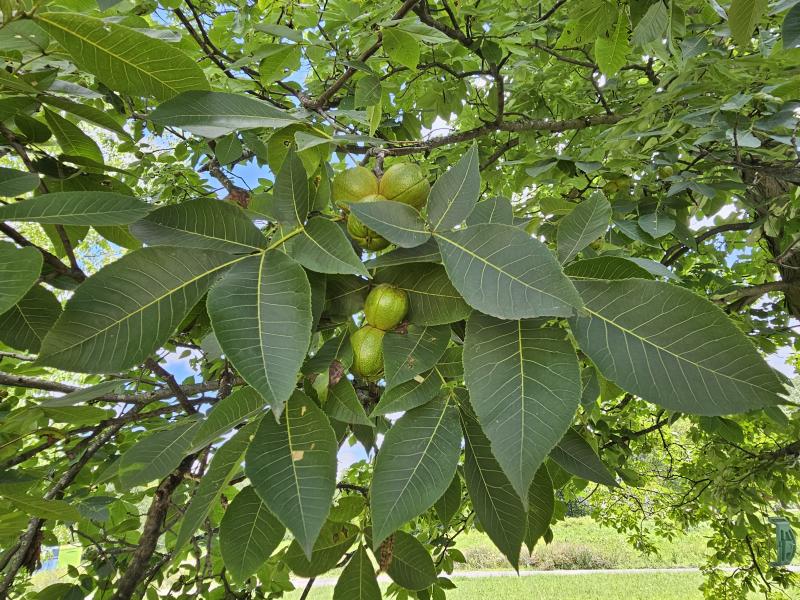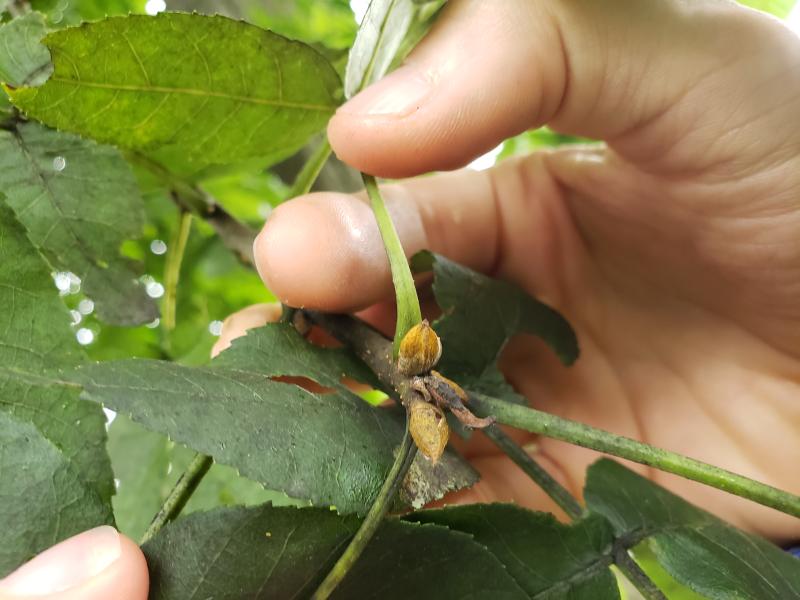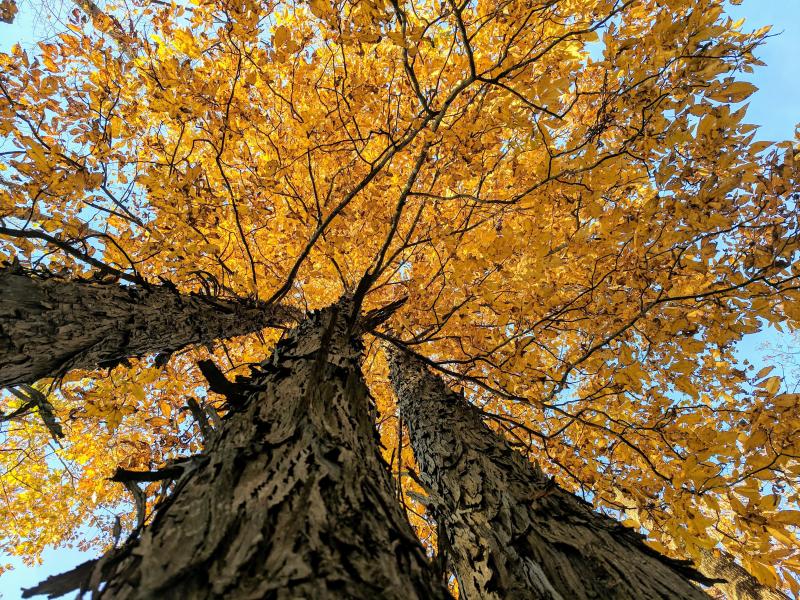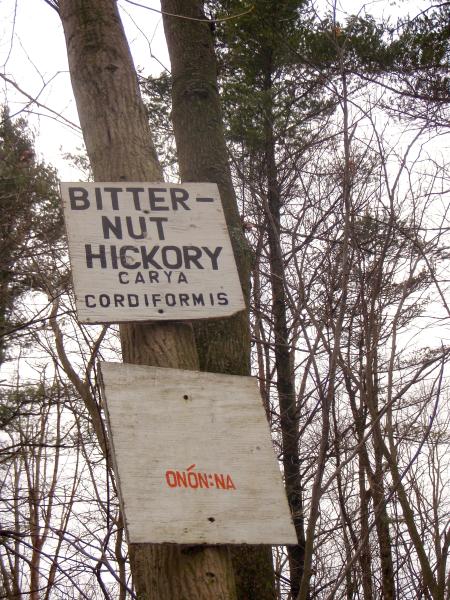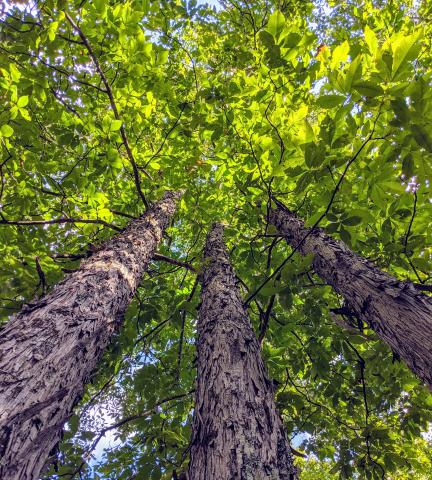
Names and Their Meanings
Shagbark Hickory - Carya ovata
Bitternut Hickory - Carya cordiformis
Shellbark Hickory - Carya laciniosa
Shagbark Hickory
Description
Shagbark Hickory is a tall tree, growing up to 46 m. The bark is light gray, separating into long strips that persist on the trunk, giving it a shaggy appearance. The deciduous leaves are alternate and pinnately compound, with 5 leaflets that are oval shaped, 4- 7 inches long, finely teethed along the margins, and the end leaflet stalked. The terminal leaflet is much larger than the others. The aromatic fruit is a spherical nut encompassed in a green husk that grows singly or in clusters up to 3, turns brown upon maturation, and splits in 4 sections. Shagbark hickory likes deep, rich, moist soils, occurring in forests on floodplains and river bottoms. The fruit matures from September to October, and the seeds are dispersed by gravity, birds and mammals.
Conservation Status
S5 (Secure) in Ontario
Bitternut Hickory
Description
Bitternut Hickory also grows extremely tall, between 50 and 150 feet. It has a pyramid shaped crown, with the trunk appearing long in comparison with a short crown. It’s deciduous leaves are alternate, pinnately compound and turn bright yellow in the fall. There is a slight pubescence on the leaf midrib (pictured below). This and the bright, sulfur-yellow buds that persist through the winter are key features of C. cordiformis. Nuts are around one inch in length/ width, and contain four parts. Fruit husk is thin in contrast with two other Carya species described here. The nut tip is sharp, and the kernel is bitter. Bark grey-brown, smooth when young and slightly, shallowly furrowed, and the heartwood is reddish-brown. This hickory grows in sun, partial shade and shade in a variety of soils such as moist or rich, and is flood tolerant, growing in low woods, along streams and rivers, at the base of moist slopes and cliffs.
Conservation Status
S5 (Secure) in Ontario and New York State
Shellbark Hickory
Description
Shellbark hickory is the slowest growing of the three. It is a large tree with short, stout limbs and a narrow crown, growing from 90 to 130 feet tall. Like Shagbark hickory, it also has shaggy bark, yet the bark appears more deeply furrowed. Leaves on Shellbark hickory are compound being the largest of the three, from 12 to 24 inches long. The terminal three leaflets are biggest and get smaller away from the leaf tip. The weight of the nuts and leaves require large stout twigs to support them. The fruit (nut) is huge, with a thick husk that splits along sutures that number between 4 – 6 sections. Nuts grow solitary or in clusters of 2 or 3, are 1 to 3 inches in diameter; the thick husk grows up to ½ inches, splitting easily along the ribs at maturity. Although Shellbark and Shagbark hickories are very similar, Shellbark are distinguished by their larger leaves, more leaflets, larger nuts and orange twigs. They are not nearly as common as Shagbark hickories, but their nuts are renowned to be very tasty! Shellbark has affinity towards low-lying floodplain type forests. In contrast, Shagbark grows higher on the slope and on dryer sites.
Conservation Status
S3 (Vulnerable) rare in Ontario and also ranked S3 in New York State
Uses
Hickories are all extremely useful trees, providing hard wood that has been used for centuries for tools, building materials, technology, basketry and fuel. The nuts are an extremely important source of food for humans, primarily being harvested once they mature and fall to the ground. Shagbark hickory (Carya ovata) is historically and currently used to make the sticks for lacrosse, the Haudenosaunee sport that they call the Creator’s game. The hard wood of Shagbark hickory has also historically been and is currently used to craft bowls, spoons, paddles, and for housing timber. Shellbark hickory wood has been used for basketry, snowshoe frames, barrel hoops, ladders, and tool handles. Bitternut hickory was historically and is currently used to make bows, snowsnakes (a uniquely Haudenosaunee and Anishinaabe winter sport), lacrosse sticks, tools, and the wood has a distinctive flavor when used for smoking meat and fish (the source of hickory-smoked foods).
Kanyen'kéha linguist, cultural educator and elder Tehahenteh Miller notes that hickories are still used at Six Nations of the Grand River to make lacrosse sticks, snowsnakes, and bows – the traditional knowledge of which are all important elements of the continuance of Haudenosaunee cultural practices. Alyssa General and her father spoke with Dr. Dolan one day about the cultural significance of hickory trees, noting that they are cultural significant trees for crafts & utility and at nut-bearing time in the autumn months. They are the source of wood for lacrosse sticks, snowsnakes, and mudcats (snowsnakes are long sticks measuring 6.5 feet, and mudcats are shorter, at 37 inches long). Snowsnake as a sport is meant to uplift the spirits in the middle of winter (like a medicine). Snowsnake is a medicine society, like lacrosse, but it is enjoyed as a game as well. While lacrosse is a summer game, snowsnake is a winter game. Alyssa General’s father recounted the origin of snowsnake: “Snow snake comes from poor hunters. In the winter, they’d throw their arrow and miss and it slides along the snow and they became fascinated with it as a game.” He noted that Anishinaabe make a wider track on the ground than Haudenosaunee, who create a long narrow track out of snow. Originally, the track for snowsnake was made by horse-drawn sleighs, which eventually changed to creating an elevated chute with a long log. In creating the track, people let it sit for a while so that it will get icy – like a night or two. It is played and enjoyed primarily by men, but there is a version that women play that is slightly different with a circular track.
In Frederick Wilkerson Waugh’s notes from 1912, John Arthur Gibson described to Waugh that hickories were growing plentifully along the Grand River and in neighborhoods at Six Nations, and were used for food, dyes, pounded as an ingredient in soups; Shagbark and Shellbark nuts were mixed with other nuts (except acorns) and either beans or berries and made into bread – or made into a gravy (Waugh Box 200 F1; Box 22 F7). Haudenosaunee and Anishinaabe have made tasty hickory nuts into pies and cakes for over a Century. Scott Herron described Anishinaabe using bitternut and shagbark hickories extensively for craft and utility. Amber Adams noted that shagbark hickory is part of the Haudenosaunee Creation story. Rick Hill and Chandra Maracle noted for their Healthy Roots traditional foods research that nuts from all three hickories are a nutritious source of proteins and fats.
